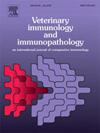禽分枝杆菌亚群主要膜蛋白。副结核激活免疫和自噬途径在牛单核细胞来源的巨噬细胞
IF 1.4
3区 农林科学
Q4 IMMUNOLOGY
引用次数: 0
摘要
禽分枝杆菌亚种副结核(Map)是反刍动物约翰氏病的病原,对兽医卫生和食品安全构成挑战。尽管免疫反应部分控制早期感染,Map通过尚不清楚的机制在巨噬细胞中持续存在。在这里,我们探讨了Map主要膜蛋白(MMP)如何调节牛单核细胞来源的巨噬细胞的免疫途径(MoMΦs)。MMP是牛约翰氏病细菌细胞膜的关键组成部分,使其成为免疫研究的重要抗原靶点。通过高分辨率转录组学,我们发现MMP刺激可以通过MHC I和II途径快速激活与促炎细胞因子信号、抗原加工和递呈相关的基因。基因本体和KEGG通路富集分析强调了TNF、IL-17和NF-κB信号级联的上调,表明免疫信号可能促进细胞毒性T细胞的发育。磷酸化实验证实MMP在几分钟内触发MAPK激活,暗示p38和JNK1/2参与早期巨噬细胞反应。机器学习方法揭示了微妙但重要的mmp特异性基因特征,包括ATG5和ATG12,涉及自噬体组装。这些发现指出了牛巨噬细胞中抗菌自噬和MMP引发的免疫刺激途径之间的动态相互作用。重要的是,我们的结果表明MMP作为一个潜在的疫苗靶点的相关性,因为它不仅引发免疫激活信号,而且参与对限制Map存活至关重要的宿主防御。总的来说,这项工作为描绘Map感染的分子基础提供了一个离体框架,为巨噬细胞免疫提供了新的见解,并为开发新的治疗和预防副结核病的策略提供了信息。我们的数据为转化研究开辟了道路,阐明了MMP、巨噬细胞和保护性宿主免疫之间的相互作用。本文章由计算机程序翻译,如有差异,请以英文原文为准。
Major membrane protein of Mycobacterium avium subp. paratuberculosis activates immune and autophagic pathways in bovine monocyte-derived macrophages
Mycobacterium avium subspecies paratuberculosis (Map), the etiological agent of Johne’s disease in ruminants, poses challenges to veterinary health and food safety. Despite an immune response that partially controls early infection, Map persists in macrophages through mechanisms not well understood. Here, we explored how the Map major membrane protein (MMP) modulates immune pathways in bovine monocyte-derived macrophages (MoMΦs). MMP is a key component of the bacterial cell membrane recognized in cattle with Johne’s disease, making it a critical antigenic target for immune studies. Using high-resolution transcriptomics, we identified that MMP stimulation rapidly activates genes linked to pro-inflammatory cytokine signaling, antigen processing, and presentation via MHC I and II pathways. Gene Ontology and KEGG pathway enrichment analyses highlighted upregulation of TNF, IL-17, and NF-κB signaling cascades, suggesting an immune signaling that may foster cytotoxic T cell development. Phosphorylation assays confirmed that MMP triggers MAPK activation within minutes, implicating both p38 and JNK1/2 in early macrophage responses. Machine learning approaches revealed subtle yet significant MMP-specific gene signatures including ATG5 and ATG12, implicated in autophagosome assembly. These findings point to a dynamic interplay between antibacterial autophagy and immunostimulatory pathways elicited by MMP in bovine macrophages. Importantly, our results suggest the relevance of MMP as a potential vaccine target, as it not only elicits immune-activating signals but also engages host defenses critical to restricting Map survival. Overall, this work provides an ex vivo framework for delineating the molecular underpinnings of Map infection, offering new insights into macrophage-based immunity and informing development of novel therapeutic and prophylactic strategies against paratuberculosis. Our data open avenues for translational studies, illuminating the interplay between MMP, macrophages, and protective host immunity.
求助全文
通过发布文献求助,成功后即可免费获取论文全文。
去求助
来源期刊
CiteScore
3.40
自引率
5.60%
发文量
79
审稿时长
70 days
期刊介绍:
The journal reports basic, comparative and clinical immunology as they pertain to the animal species designated here: livestock, poultry, and fish species that are major food animals and companion animals such as cats, dogs, horses and camels, and wildlife species that act as reservoirs for food, companion or human infectious diseases, or as models for human disease.
Rodent models of infectious diseases that are of importance in the animal species indicated above,when the disease requires a level of containment that is not readily available for larger animal experimentation (ABSL3), will be considered. Papers on rabbits, lizards, guinea pigs, badgers, armadillos, elephants, antelope, and buffalo will be reviewed if the research advances our fundamental understanding of immunology, or if they act as a reservoir of infectious disease for the primary animal species designated above, or for humans. Manuscripts employing other species will be reviewed if justified as fitting into the categories above.
The following topics are appropriate: biology of cells and mechanisms of the immune system, immunochemistry, immunodeficiencies, immunodiagnosis, immunogenetics, immunopathology, immunology of infectious disease and tumors, immunoprophylaxis including vaccine development and delivery, immunological aspects of pregnancy including passive immunity, autoimmuity, neuroimmunology, and transplanatation immunology. Manuscripts that describe new genes and development of tools such as monoclonal antibodies are also of interest when part of a larger biological study. Studies employing extracts or constituents (plant extracts, feed additives or microbiome) must be sufficiently defined to be reproduced in other laboratories and also provide evidence for possible mechanisms and not simply show an effect on the immune system.

 求助内容:
求助内容: 应助结果提醒方式:
应助结果提醒方式:


